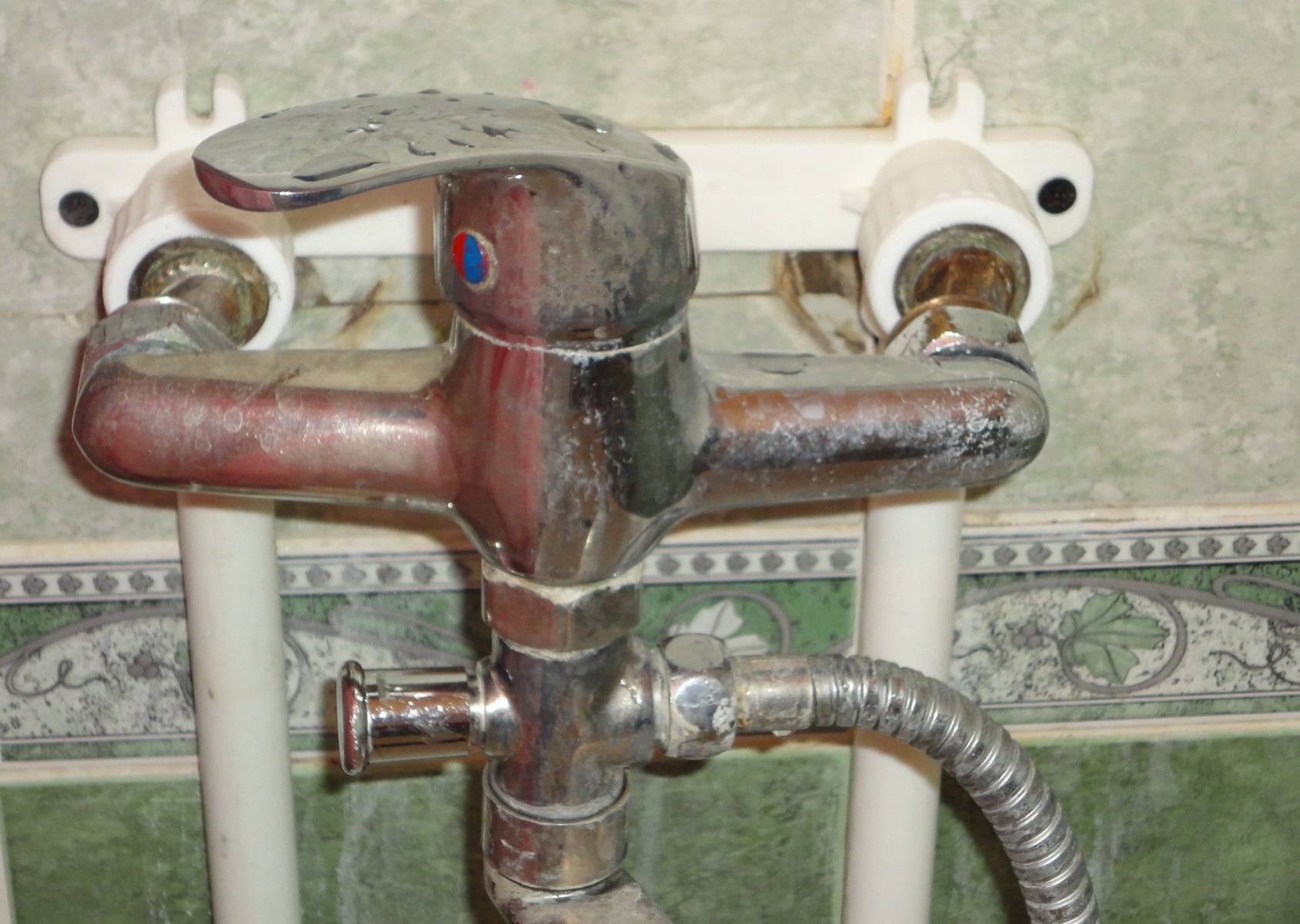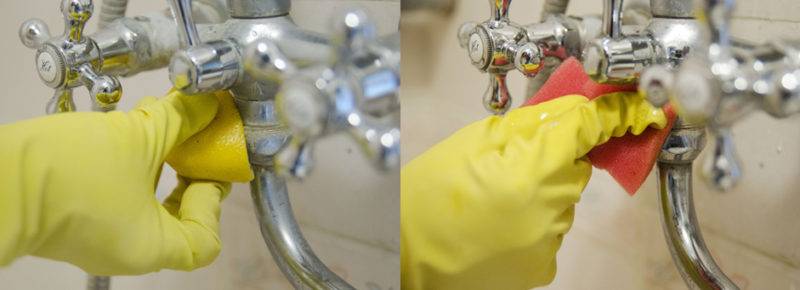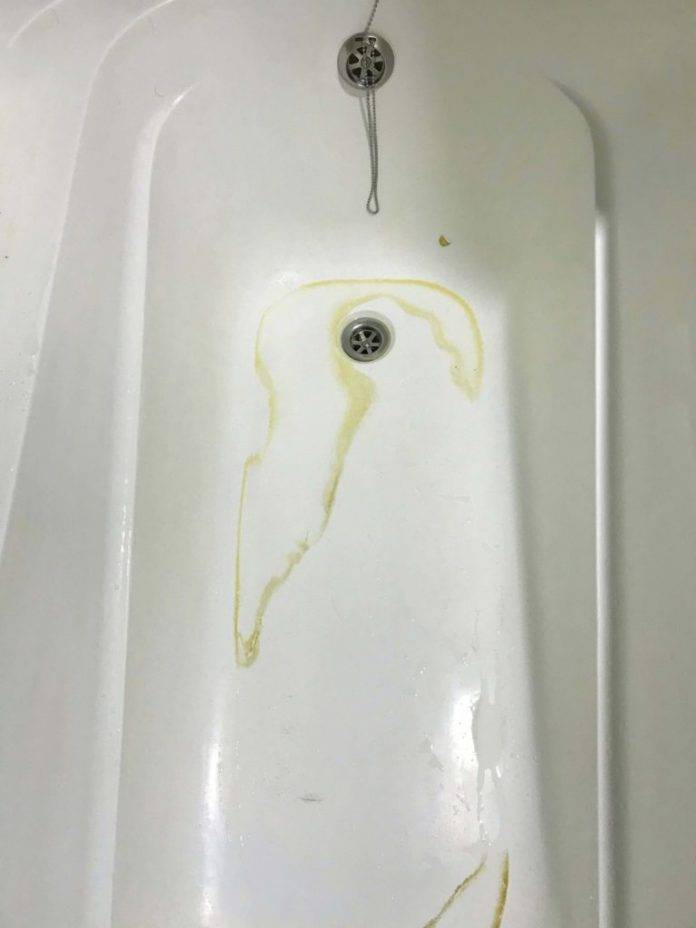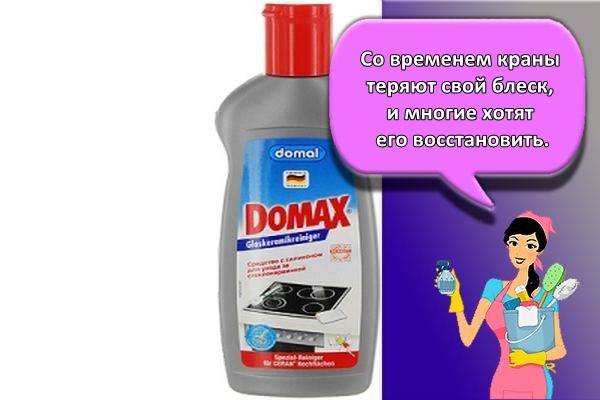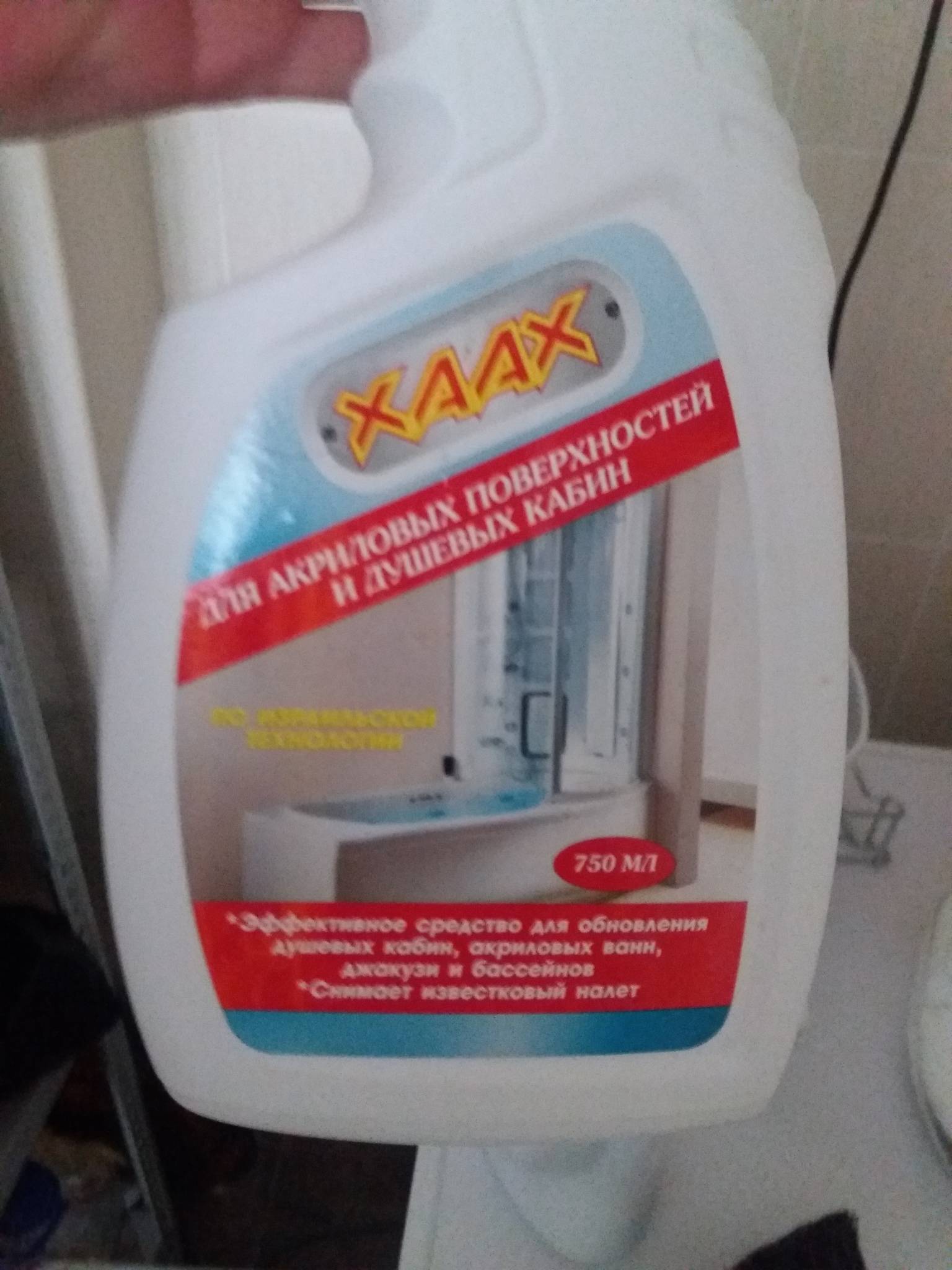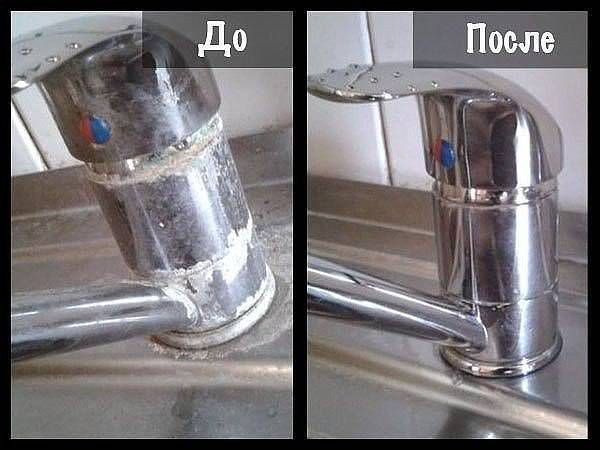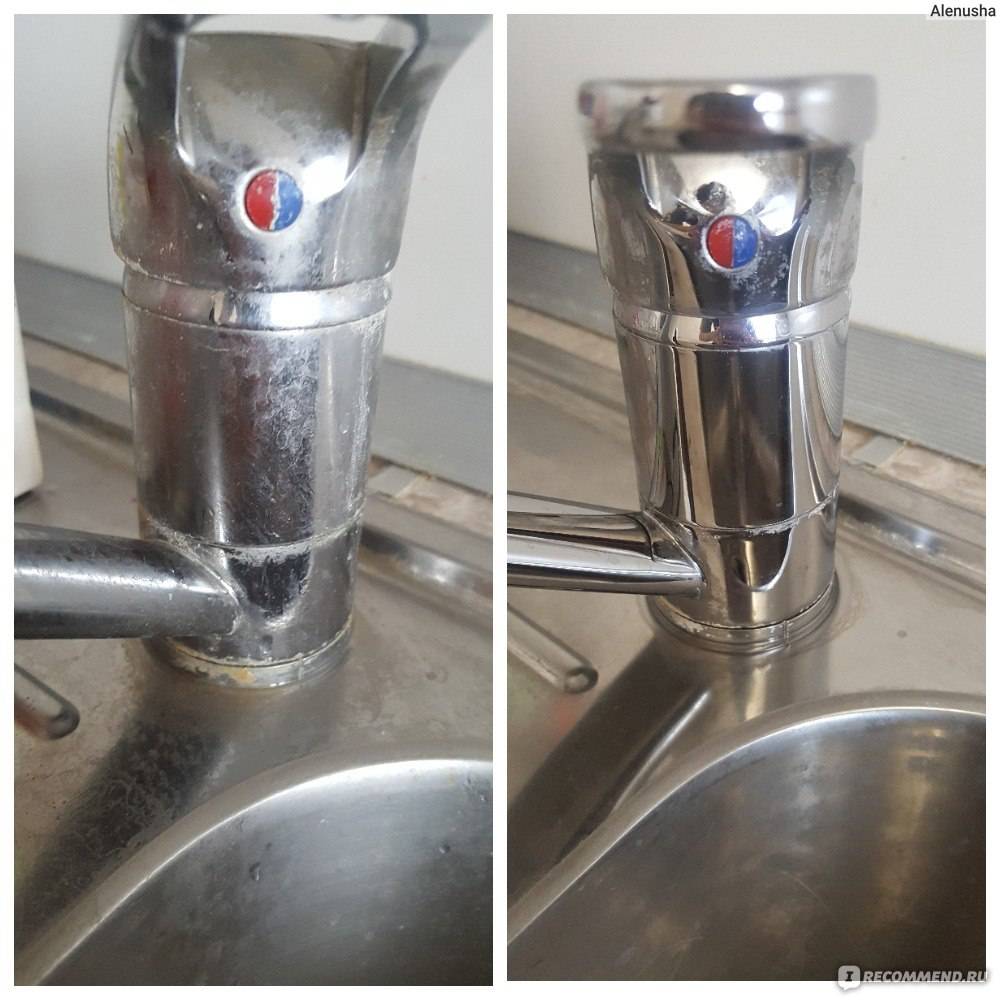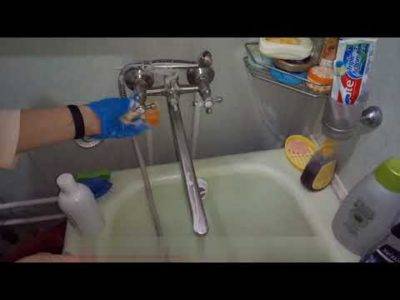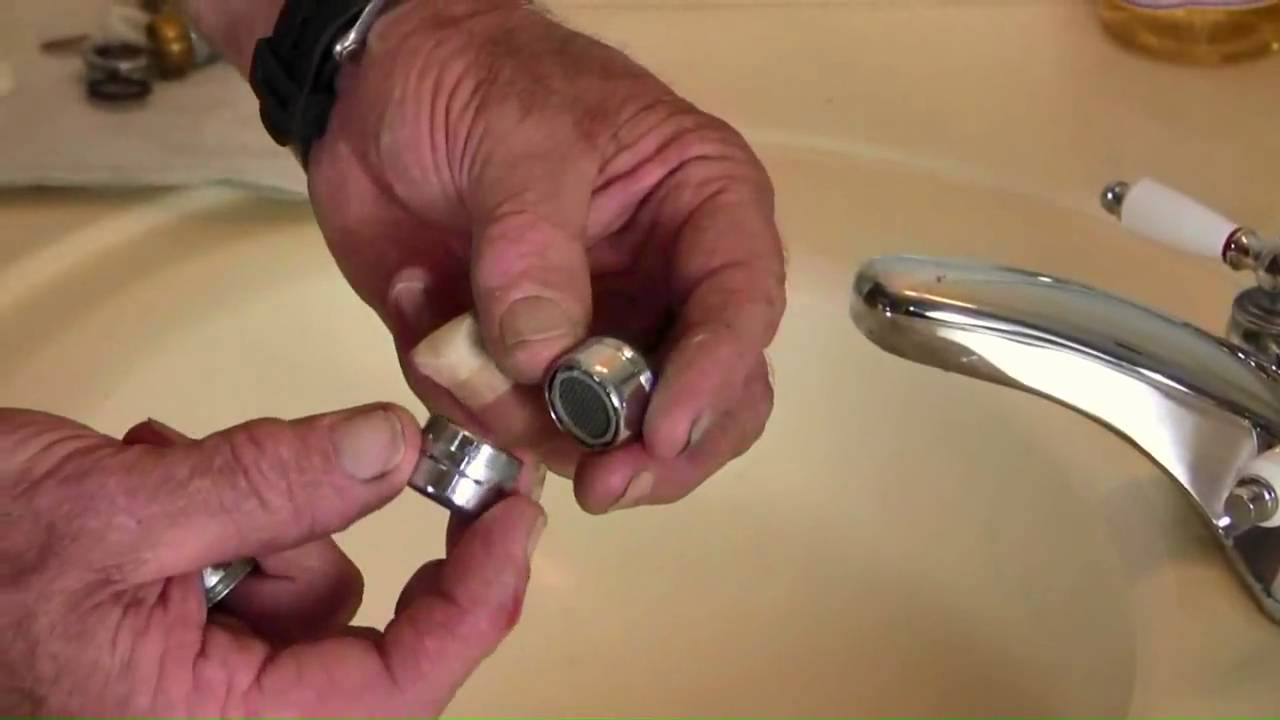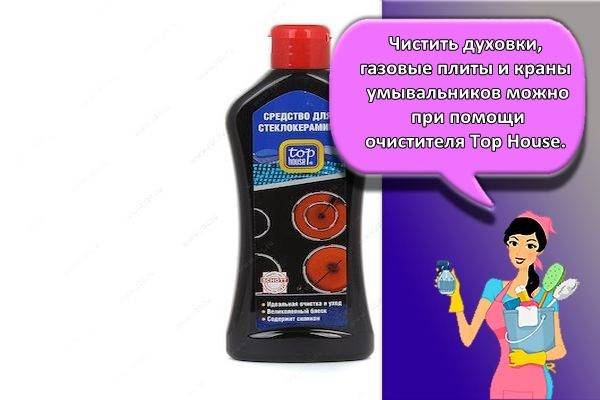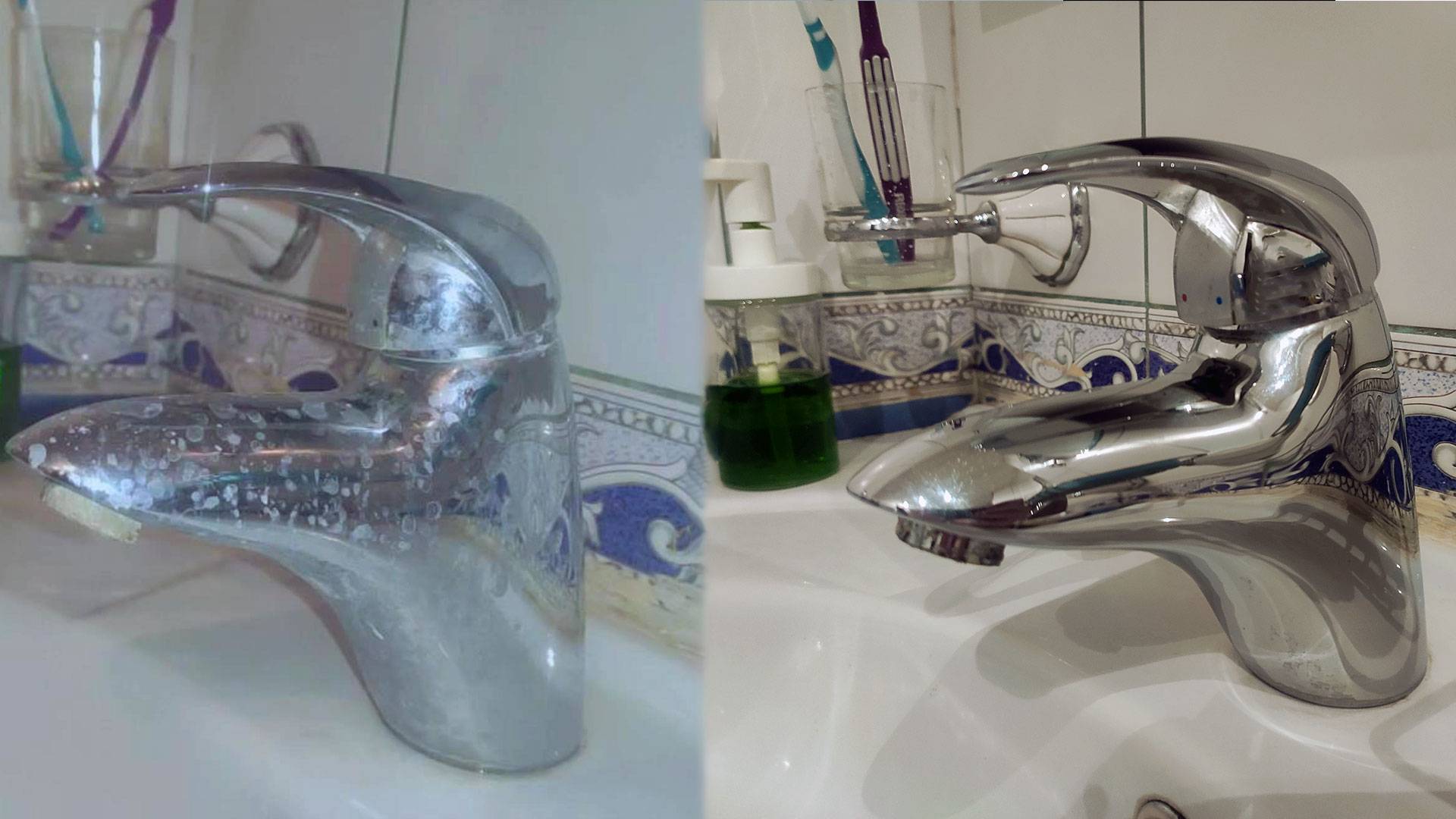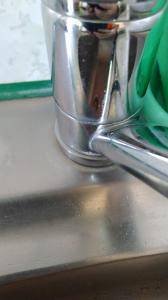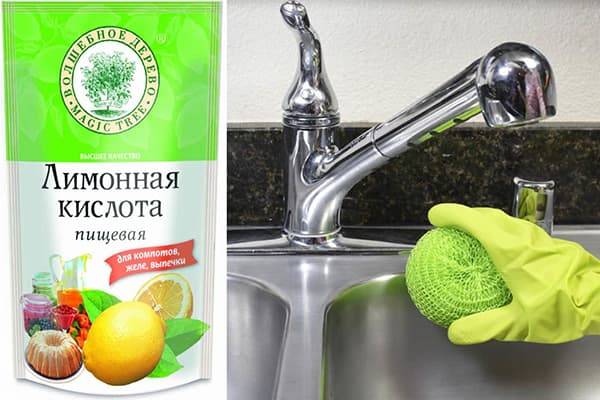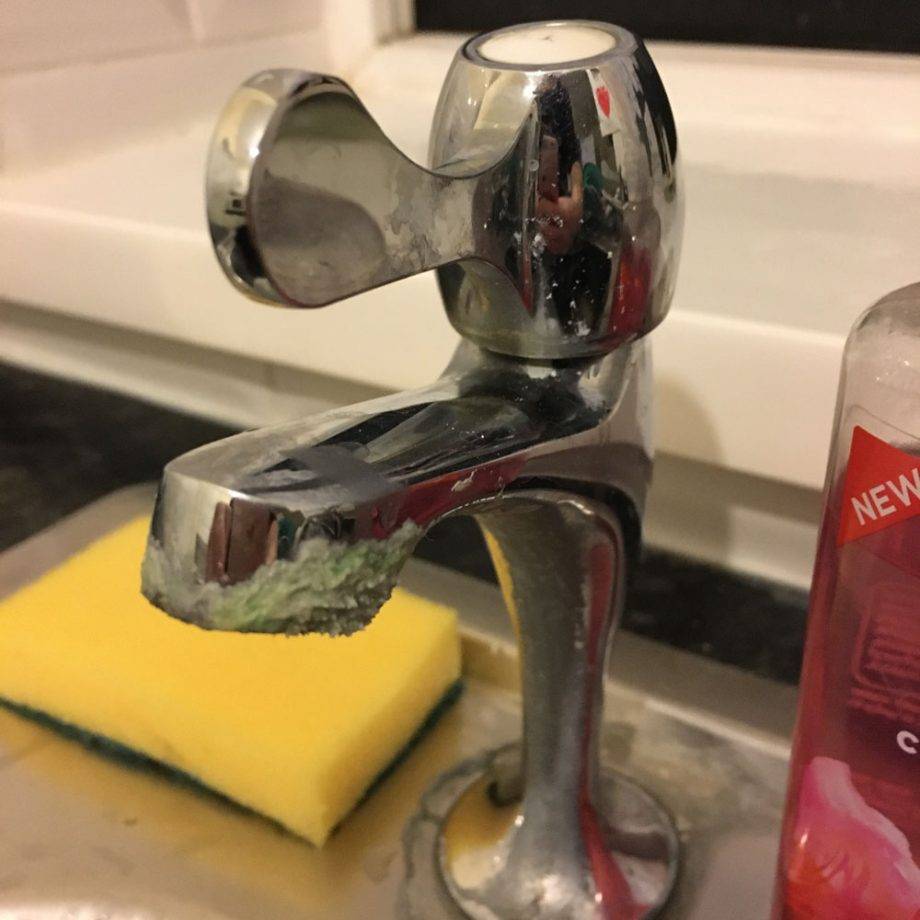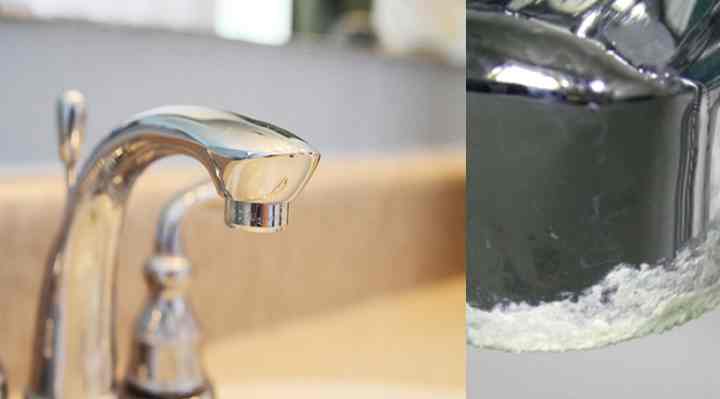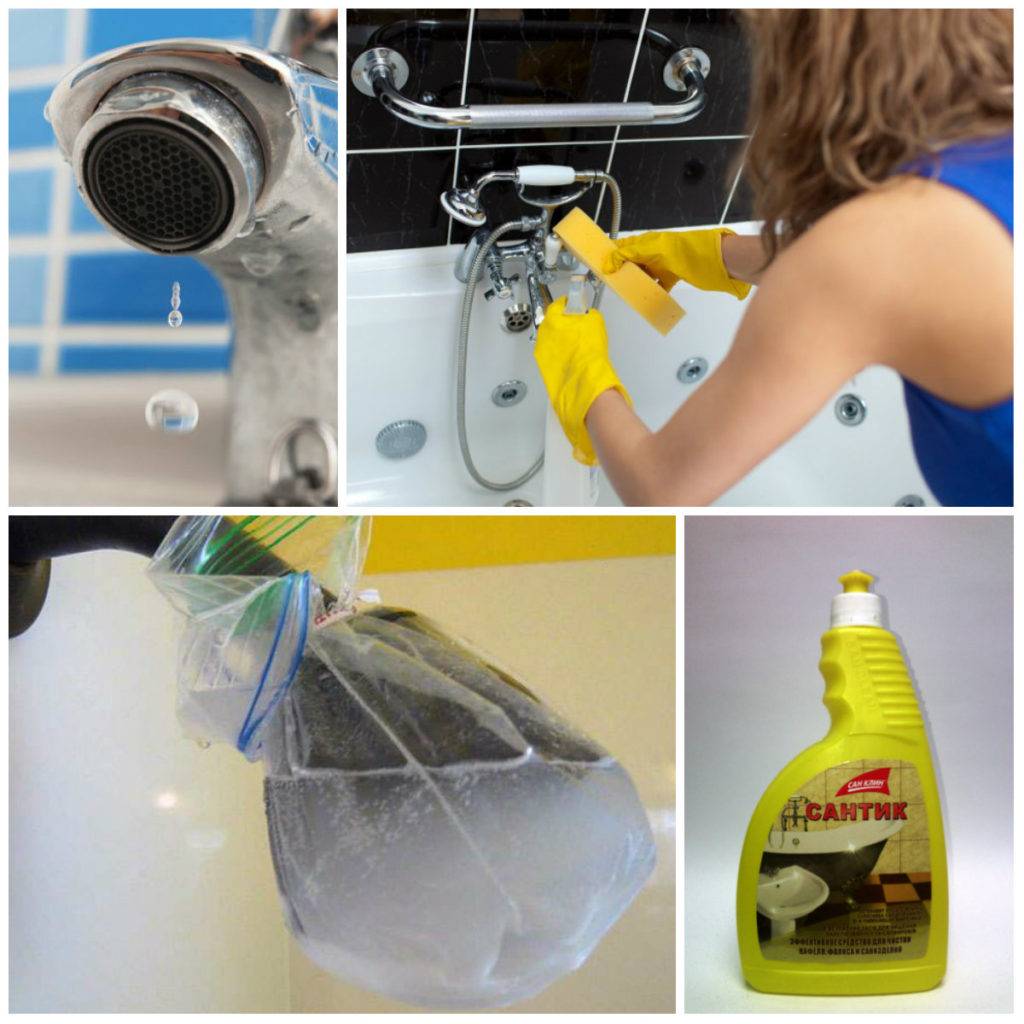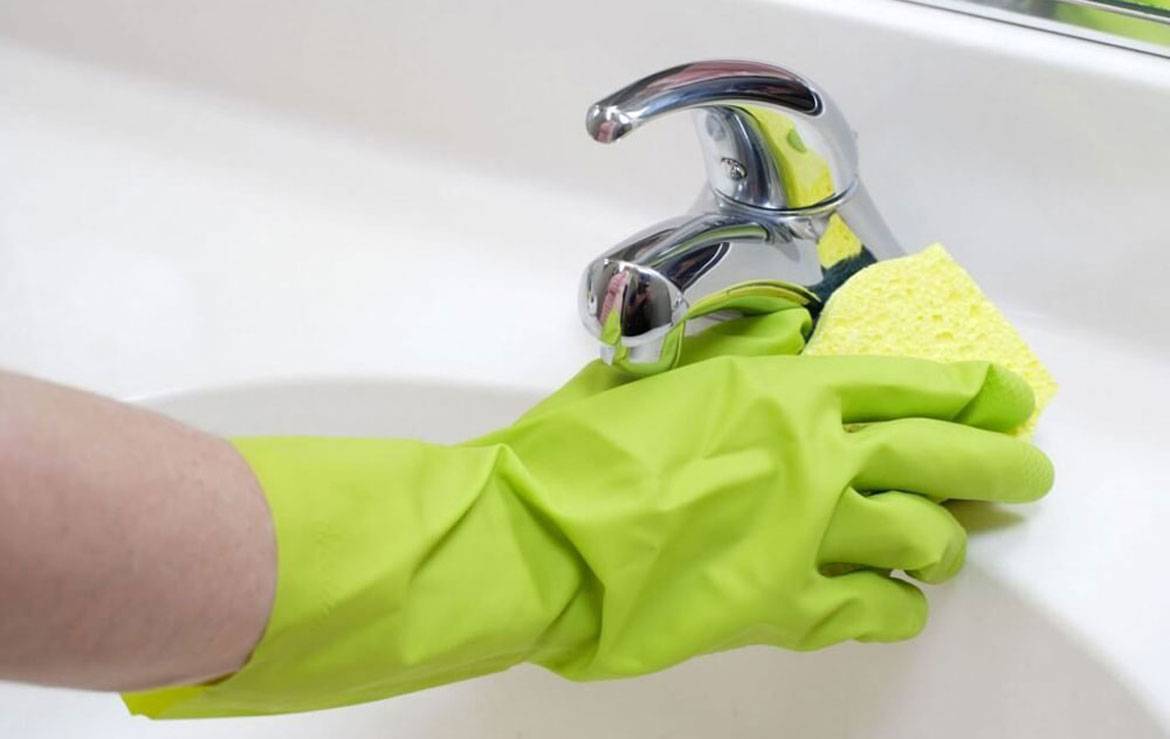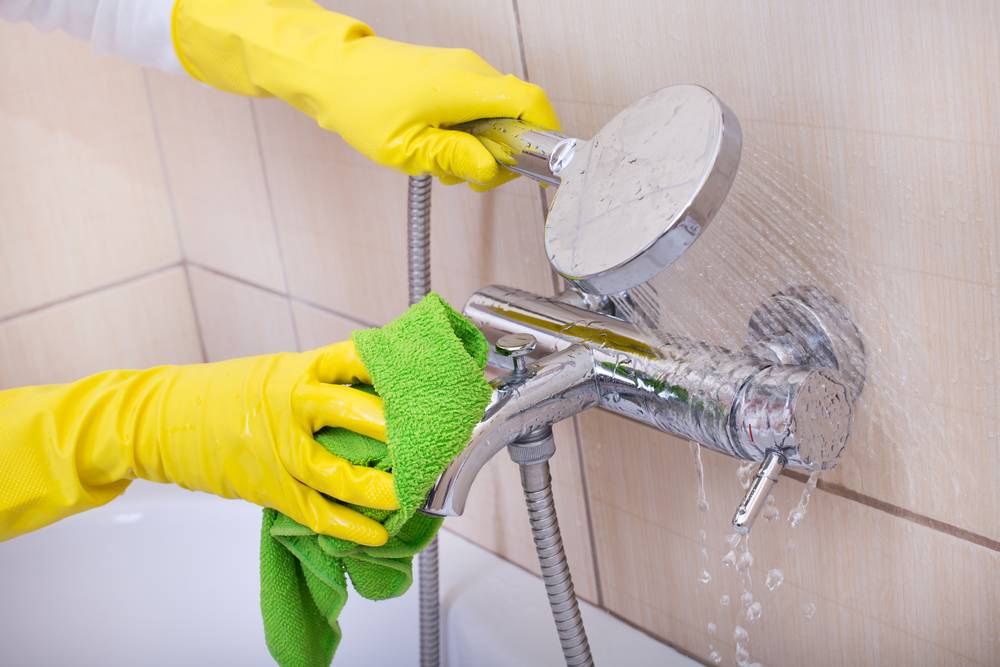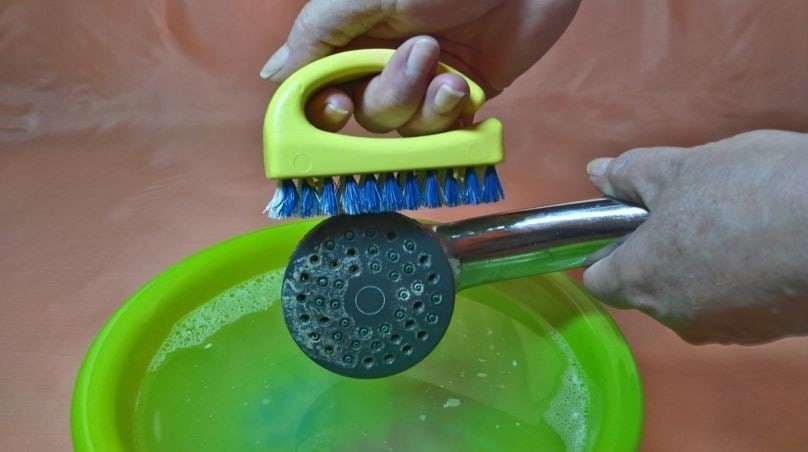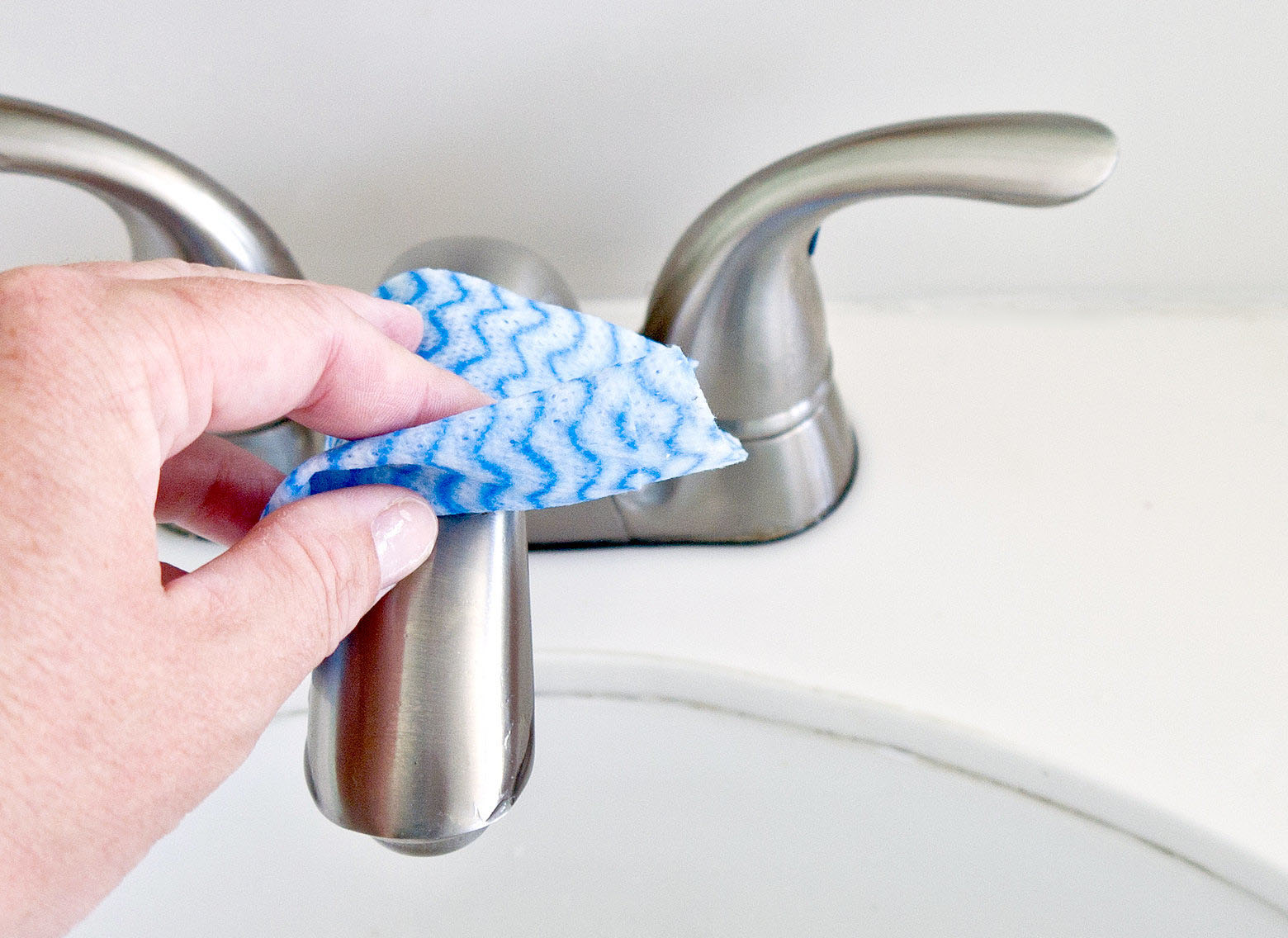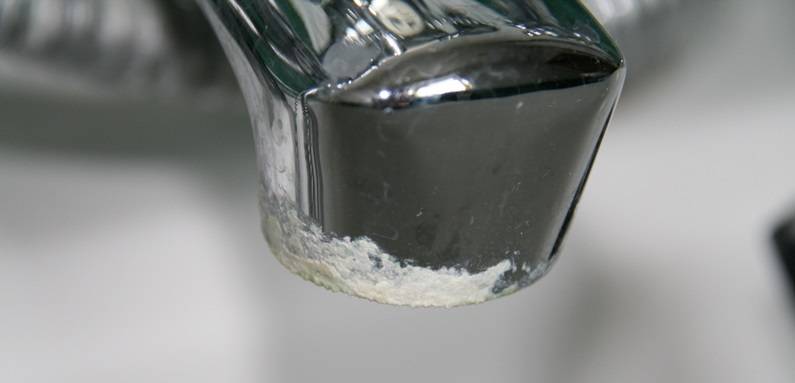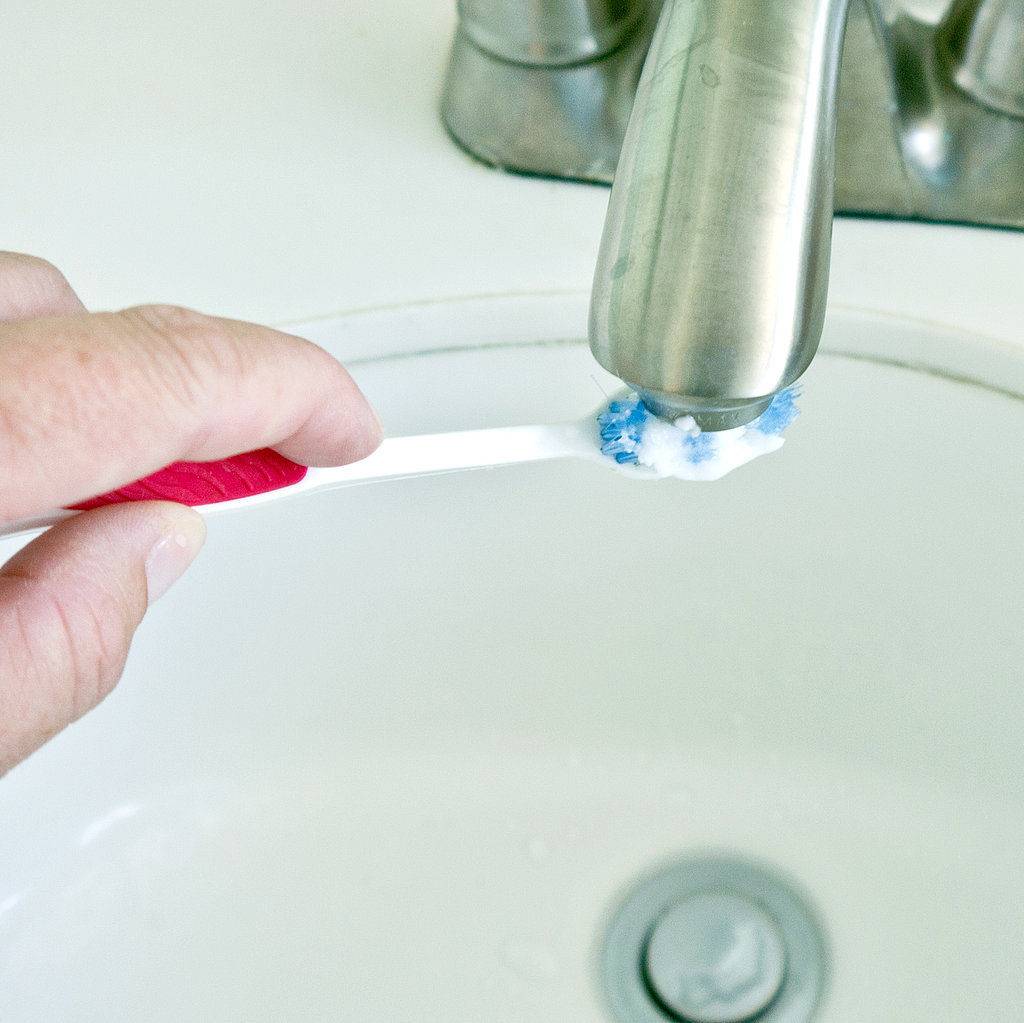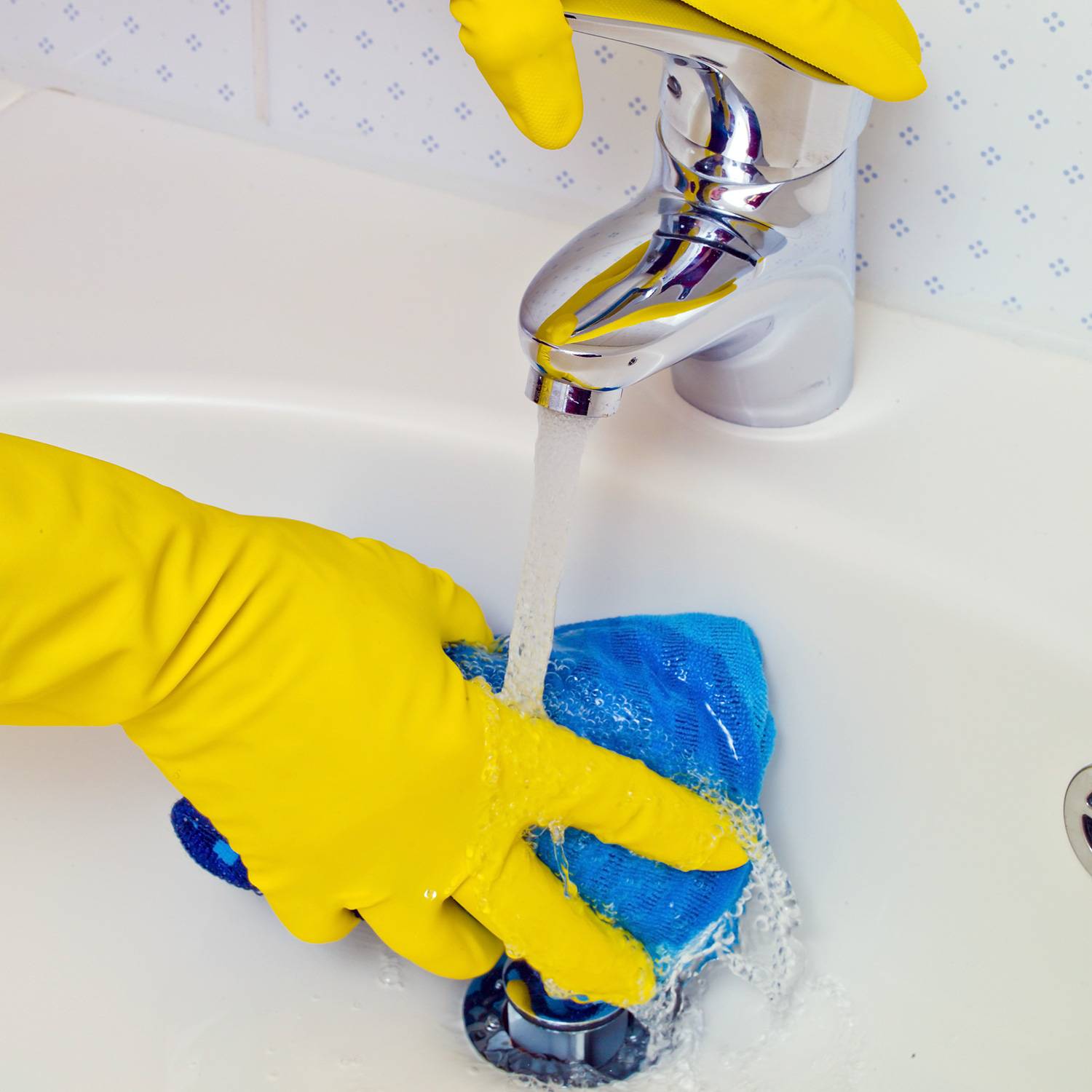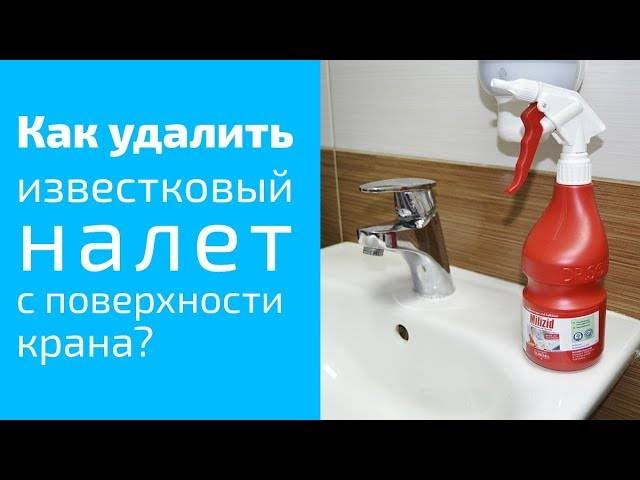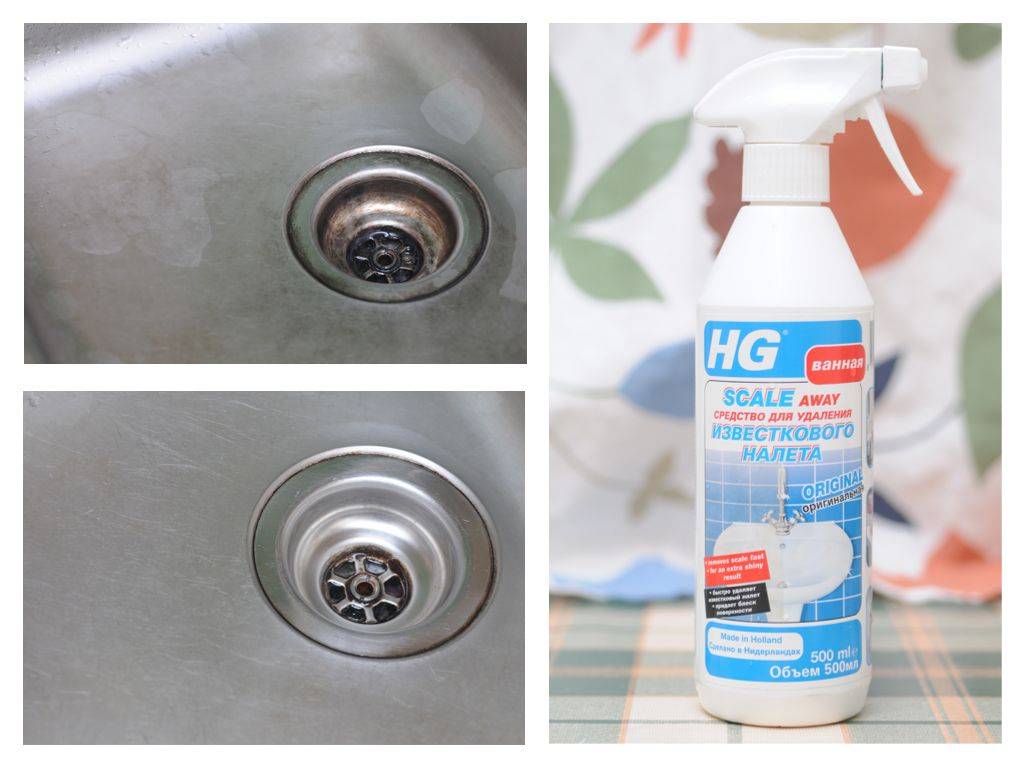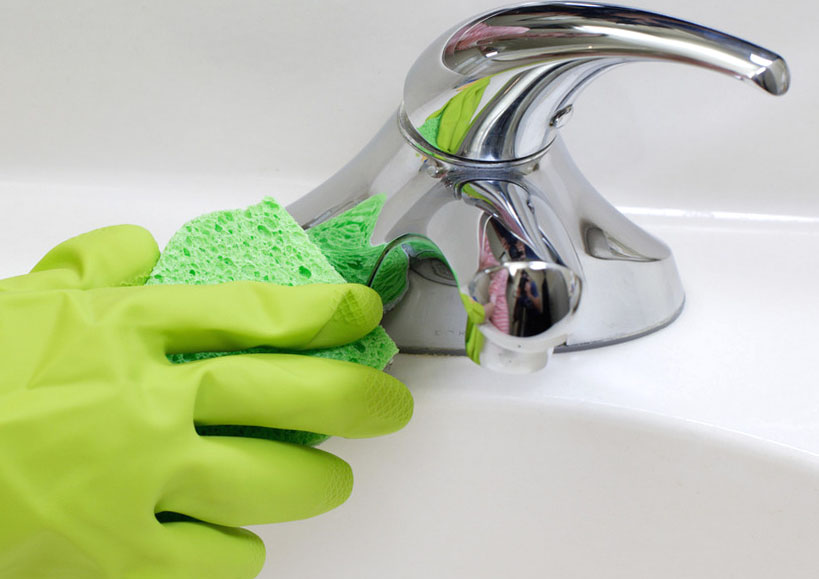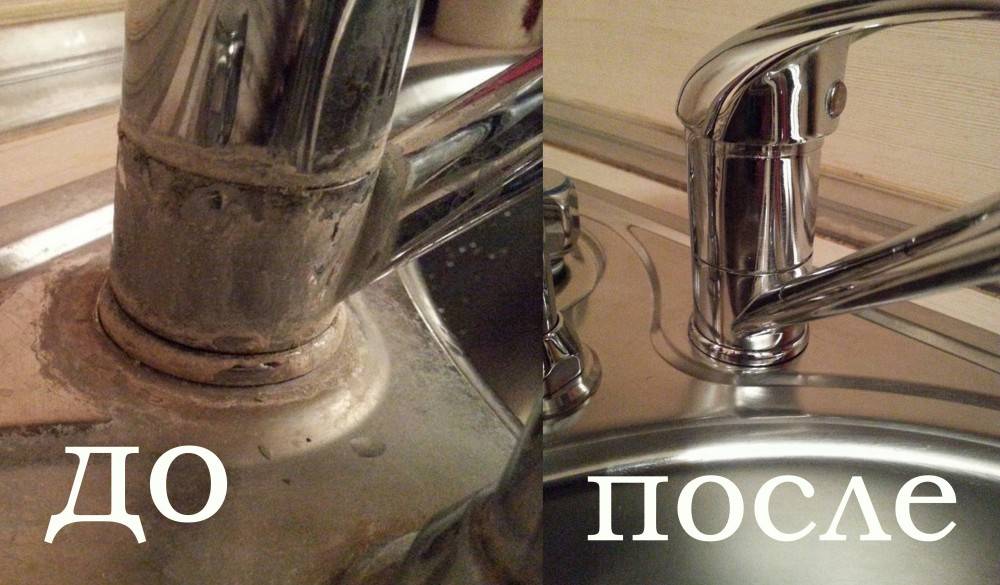A quick way to clean your faucet and shower head
When carrying out general cleaning in the bathroom, the main efforts have to be made to remove the dense lime layer from the surface of the bathtub, sink and tile. There are quite a few effective approaches, but to obtain the maximum positive result, it is recommended to use the following:
- To quickly wash ceramic tiles, spray 6% vinegar on the contaminated area with a spray bottle, wait a few minutes and remove the softened plaque with a soft brush or a thick sponge.
- Vinegar will help repair a heavily soiled sink as well. We heat a glass of 6%! Of the product to a very warm state and pour it into the sink, having previously plugged the drain with a stopper. If the lime layer remains incompletely covered, prepare a little more composition. We leave everything overnight, and in the morning we drain the product and all that remains is to clean the remnants of contamination. The toilet bowl and bathtub can be treated in the same way.
- To remove streaks that often cover the sink where the faucet is attached, it is recommended to use citric acid. Apply the product in dry form to a damp sponge and gently three pre-moistened contaminated surface, not forgetting to process the faucet and mixer.
The use of these compounds gives a double positive effect - it allows you to qualitatively clean the tiles, bathtub, toilet bowl and sink, while eliminating the unpleasant odors characteristic of the bathroom.
Almost any product can be used to clean the enamel coating, even those containing organic or alkaline solvents. The enamel of steel and cast iron baths is very resistant to their impact. Only those containing sulfuric or nitric acid are prohibited for use. How to properly clean an enamel bath with a product:
- A weak solution of citric acid or table vinegar is sprayed evenly on the surface;
- It is necessary to withstand the solution for 10-20 minutes;
- The walls of the bathroom are thoroughly rinsed with running water.
The nuances of cleaning the aerator
The aerator is a special mesh that is in the taps in order to spray water from the tap. Before cleaning it, remove and inspect for various contaminants. If there are too many of them, then use a vinegar solution in which the part should be soaked for 40 minutes.
You can remove dirt:
- laundry soap;
- baby oil;
- baking soda;
- table vinegar;
- citric acid;
- lemon;
- drink "Cola".
The advantage of this method is its health safety and good effect. First of all, you need to grate a piece of soap on a grater with large holes. Then put the grated soap into a container and pour boiling water over it so that you get a mass of thick sour cream consistency. Add soda (baking soda or soda ash) to this mass.
The cleaning technology is pretty simple:
- Pour a small amount of baby oil onto a soft cloth, dampening it completely.
- Wipe off areas with plaque.
- Wash off the oil from the surface with warm water.
- Use a suede, flannel or bike to polish the product.
Using soda
It is best to use regular baking soda. You need to pour a small amount of soda into a separate container. Gently add a little water until the consistency of thick sour cream. Apply the resulting composition with a toothbrush to the dirty area, but do not rub in order not to scratch. Leave the mixture for 50-60 minutes. Wipe the area to be treated with a piece of soft cloth
In the event that the plaque has not completely removed, you need to carefully rub this place with the denser side of a washcloth.
This recipe is loved by housewives for its speed of action. Mix water and vinegar (9%) in a 1: 1 ratio. Dampen a soft cotton cloth with this solution. Wipe off contaminated surfaces. Rinse the cleaned surface thoroughly with plenty of water. Wipe dry.
There is a second recipe, if the pollution is large and old:
- Pour vinegar into a container and heat.
- Moisten a piece of cloth with heated vinegar.
- Place the dampened cloth over the plaque area.
- Wait 1.5-2 hours.
- Remove the "compress".
- Rinse with water.
- Wipe dry.
Lemon or citric acid - another quick and an effective way to care for your mixer. It is strictly forbidden to use dry citric acid, as scratches made by abrasive crystals may appear. It is necessary to pour citric acid into the container. Place a drop of water and wipe the surface with limescale deposits. Then you need to wait 2-5 minutes and rinse the surface thoroughly.
This carbonated drink has excellent anti-plaque results. The active acids that make up the drink will clean the surface. Procedure:
- Moisten a cloth generously with the drink.
- Put the "compress" on the contaminated area.
- Leave on for 10-15 minutes.
- Remove the cloth.
- Rinse with water.
- Wipe dry.
3 Recommendations
In order not to damage the product during cleaning, you must follow some recommendations:
- It is only necessary to apply detergents on a sponge or microfiber cloth. It is unacceptable to use rigid products, they can scratch the faucet.
- Follow the instructions. Do not keep detergents on surfaces for too long.
- After cleaning, the taps should be polished to shine and wiped dry.
Traditional methods are safer than household chemicals. But keep in mind that when using acids such as vinegar or lemon, too long exposure to them can also lead to damage. It is better to first try to clean the plaque with a small amount of these funds, and then do the operation again, if you cannot remove everything the first time.
Chemical methods for removing limestone at home
You can get rid of plaque with preparations containing acid, chlorine or abrasive particles. You need to use them correctly so as not to damage the plumbing.
Acid and chlorine-based products
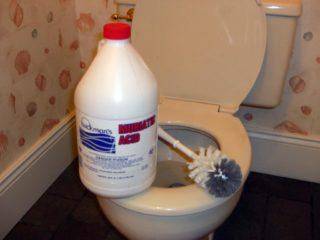 Hydrochloric acid removes even stubborn plaque on the toilet
Hydrochloric acid removes even stubborn plaque on the toilet
These are the best home toilet cleaners for stubborn dirt, limescale and scale. However, they cannot be used without protection of the skin and respiratory organs. During the treatment of the toilet bowl, the stay of people and animals near the cleaning place must be limited. Store chemicals in special lockers or compartments out of the reach of children and pets.
From serious pollution, such as many months of calcium deposits, dense blockages and others, there is "superchemistry". It can be found on the shelves of hardware and home improvement stores:
- Hydrochloric acid solution 33%. Very effective, but at the same time hazardous to health, chemical surface cleaning agent. Carefully apply the acid to the wall of the toilet bowl and pour it onto the bottom in a volume of 100-200 ml. You can rinse off the water and wipe the plumbing after 20 minutes.
- Battery electrolyte. Of the chemical cleaning agents, this is the most hazardous substance to health. The basis of the liquid is a mixture of water and sulfuric acid. In case of accidental inhalation of vapors, consciousness can be briefly switched off up to fainting, and if electrolyte gets on the skin, severe chemical burns occur. It must be used strictly according to the instructions that come with the drug.
- Chlorine based detergents. They help to effectively fight dirt and at the same time clean the toilet of strong limestone the first time. They are mainly produced in the form of a thick gel.It is necessary to apply the product for 20-30 minutes, wait until it begins to corrode the deposits on the toilet, and then rinse.
Alkalis
Whiteness contains alkali, which quickly removes plaque
In Russia, sodium hydrochloride-based cleaning products are known under the brand name "Belizna". Suitable for cleaning surfaces from lime, scale, rust at home.
The agent is applied to the walls and bottom. To treat one toilet bowl, 300 ml of liquid is enough. The water must be skimmed off prior to application. Then you need to wait 3 to 6 hours. The longer the alkali is absorbed, the cleaner the surface becomes.
Abrasive cleaners
The basis of these products is finely ground solids, for example, quartz sand, granite chips, pumice, etc. Application to the surface is carried out using dense fabrics, special sponges with a hard side or brushes with thick bristles.
Folk remedies against water stone
There are several ways to remove limescale deposits from your faucet at home. Chemical cleaners can be used. But their use is fraught with surface damage. The most effective folk remedies for limescale are citric acid and vinegar. Both substances have one thing in common - they are acidic, due to which they destroy the water stone.
Soda
Since it is not recommended to clean the faucet from deposits with abrasive tools due to the risk of scratches, try using baking soda. Put some baking soda on a sponge, slightly moisten, brush off the dirt. We clean hard-to-reach places with a toothbrush.
Soap
Use shampoo or soap to clean the mixer well. Rinse the foam thoroughly after cleaning! Otherwise, a sludge will remain on the surface that can cause corrosion.
Vinegar
To remove the remaining rusty water on the faucet spout, pour vinegar into a plastic cup, secure it so that the faucet is immersed in the liquid, leave for 1 hour. Rinse. This method of applying vinegar will also help to clean the faucet from the inside and remove plaque from the mesh.
You can also moisten cotton wool with vinegar, which then wrap around the spout, fix, leave for 1 hour. Then rinse. Gently wipe the rest of the water stone with a cloth dipped in vinegar.
You can clean glossy surfaces to a shine with a solution of water, vinegar, lemon juice (1: 1: ½). Pour the mixture into a spray bottle, apply to the faucet, and leave for 30 minutes. Wipe the product with a cloth, polish with a microfiber cloth.
Lemon
The faucet will shine clean when cleaned with lemon. Cut a lemon, wipe the entire product. Leave overnight, rinse in the morning, wipe dry.
Citric acid is another readily available product that can clean your faucet well. It can be used to descale the entire bathroom. Apply a small amount of water solution (10 g acid to ½ liter of water) on a sponge or cloth, thoroughly clean the surface. This substance causes a violation of the structure of minerals, ensuring the elimination of scale and limescale. Citric acid works like professional scalers.
Coca Cola
One unusual cleaning method for removing limescale from a tap is with Coca-Cola. Pour soda into a spray bottle, apply to mixer and tap. Wipe them off before cleaning. After a few minutes, rinse with water, wipe with a cloth.
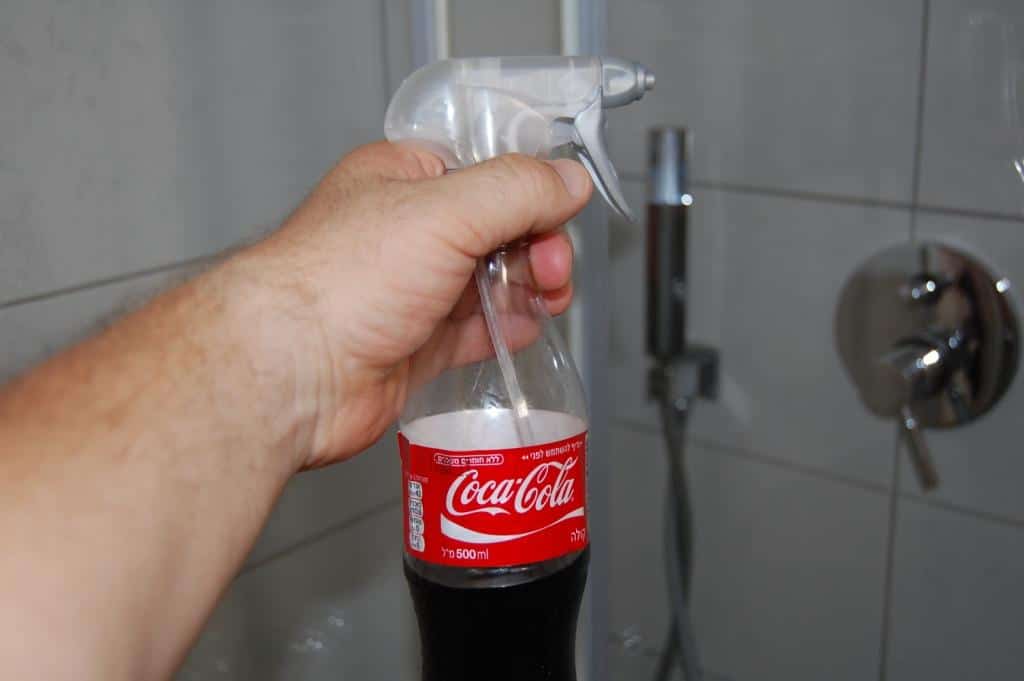
Using soda in the same way as vinegar (on the spout - see above), you can clean the faucet that is clogged from the inside.
Household cleaners
It can be difficult to clean a faucet (ball or other type) in the bathroom or kitchen, as dirt can penetrate into many hard-to-reach places. But there is a way to effectively clean the faucet:
- Use Cif Scale Remover. Moisten a cloth with it, wrap the tap so that the detergent acts on all metal parts of the mixer.
- To clean the spout, fill a cup with detergent, immerse the tap in it, secure to keep the spout submerged in the cleaner. This action will also help clean the faucet screen.
- Leave the product to act for up to 1 hour. Most of the plaque will dissolve.
- Residual tough scale can be gently removed with Cif Original Liquid Powder.
You can also use a limescale cleaner formulated specifically for bathrooms, such as Cif Power & Shine in a practical spray bottle. It is convenient to use for cleaning hard-to-reach places.
Aggressive (eg "Savo") and abrasive cleaners scratch the surface of the mixer, so it is best not to use them.
Polishes
Keeping your home clean and shiny is a real challenge. This especially applies to the bathroom, in particular to the faucets. It is enough to wash your hands a couple of times a day, and they immediately become covered with drops. How to solve this problem?
To keep your taps shiny, try waxed food paper that acts like a polish. Rub it over the surface, creating a coating that keeps the chrome finish shiny. In addition, the waxed paper forms a waterproof protective layer so that water does not accumulate on the mixer.
Special compositions for plumbing
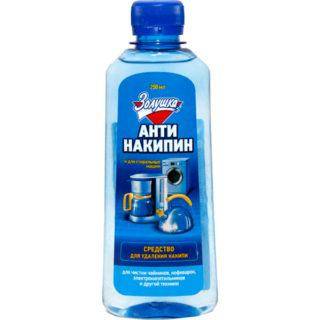 Place the faucet in a solution of liquid decalcifier to clean the inside
Place the faucet in a solution of liquid decalcifier to clean the inside
Liquid "Anti-scale" and Cillit will clean the faucet from the outside and from the inside. To do this, you will have to first remove it, or at least unscrew it from the sink and leave it to soak in the prepared solution. After soaking, it remains to rinse the tap with clean water and reinstall it in its original place, then drain the water so that the inner surface is thoroughly rinsed from dirt.
You should not purchase products containing nitrogen, salt, sulfur or phosphorus compounds to remove limescale. The use of such compounds can lead to a new problem - the formation of dark spots and difficult to remove rust, so they are best used in very rare cases. Manufacturers of such products are obliged to inform buyers about the content of potent substances by the inscription on the label.
Methods for cleaning rust and limescale from a bathroom faucet
Getting rid of unsightly rust and limescale on the tap is a difficult and time-consuming task for the hostess.
To remove limescale, two options are suitable - use ready-made household chemicals from the store or seek help from folk recipes.
Both methods have advantages and disadvantages, but they are successful. Which one to choose depends on preferences, the complexity of the pollution.
Folk remedies
When choosing components for removing limescale, be careful, do not violate the proportions, it may cause damage to the surface, corrosion. Select compositions according to the type of material from which the valve is made.
Recipes suitable for bronze and brass:
- Cut the lemon in half, sprinkle the pulp with finely ground table salt. Attach to plumbing, rub well. From the treatment, the limescale on the tap will disappear, the former shine will return.
- Rub the tarnished faucet and mixer with enough tomato paste, leave to act for 30 minutes. Rinse with cold water, wipe with a cloth.
- Combine salt, vinegar 6% and wheat flour in a small bowl. The proportions are 1: 1. Lubricate the structure with the finished mass, rinse with cool water. At the end of the process, wipe dry.
- Mix sodium and potassium 1 tbsp each. l. Apply the caustic solution in an even layer over limescale, leave for half an hour. After the time has elapsed, rinse thoroughly and dry the mixer. The solution removes stubborn dirt with ease.
- Dilute chicory in powder form with water until a creamy state is obtained, distribute over bronze. After 10-15 minutes, rinse, rub.
The methods will return a noble matte shine, remove limescale on the tap.
To clean a stainless steel and copper structure, the following options are recommended:
- Disassemble the mixer and tap gander into separate parts, place in a saucepan or bucket. Fill with water, add 1 tsp. salt and vinegar. Bring to a boil, let stand for a few minutes, until all limescale on the tap is gone. Dry and collect.
- Pour some Coca-Cola into a spray bottle and spray over the products. Leave the soda on for 20 minutes, then wipe with a dry cloth. The recipe helps remove unpleasant odors and is often used to unclog blockages in pipes and siphons.
To get rid of chrome and nickel limescale, you can use:
- Sprinkle some baking soda on a soft sponge or cloth previously soaked in water. Spread over a whitish layer, rusty streaks, leave for half an hour. Rinse with cool water.
- 6% vinegar will help get rid of limescale on the tap at home and defeat the fungus in the bathroom. Pour acid into a spray bottle, spray problem areas. The dissolving time is 10 minutes. Finally, wipe with a cloth.
- Add 1 tbsp detergent to 200 ml of heated water. l. Moisten a sponge in the solution, carefully clean the deposits.
To remove rusty streaks, limescale in hard-to-reach places, use the following techniques:
- Buy dental floss from your pharmacy. Measure 30-50 cm, run it at the joints between the valves, in other places, rub it well. After processing, rinse the mixer, wipe dry.
- Apply a small amount of baking soda to an old toothbrush. Drop vinegar on top. Clean the inside of the tap and the joints with gruel, then turn on a strong pressure to remove the remains of limescale from the tap.
- Prepare a weak solution of citric acid (4 tablespoons), liters of water. Lubricate all contaminated parts, leave for two hours. At the end of the specified time, wash and wipe the tap.
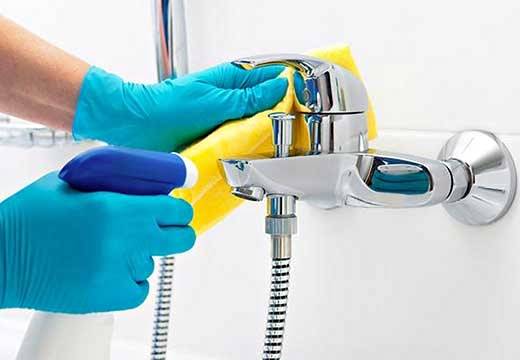
Chemistry
If there is no trust in folk methods, try ready-made products from stores.
When buying household limescale cleaners on the tap, read the instructions so as not to purchase a product that is contraindicated for your type of product.
Household chemicals are divided into types: rust removal, polishes. To combat limescale on the tap, get the first look, with the second you can modify and bring the product to the ideal.
Popular household chemicals from tap plaque:
- Shine of steel Selena;
- Top House marked for stainless steel;
- CONS-Effect;
- Trilon;
- Electrolux Stainless steel cleaner spray for limescale;
- Cillit Bang marked on bottle for metal surfaces;
- Neoblank;
- Pufas Glutoclean.
For a protective film and shine, apply polish after removing limescale from the faucet. Indesit, Domax, HG Steel Polish have good properties.
Why does plaque appear on the toilet
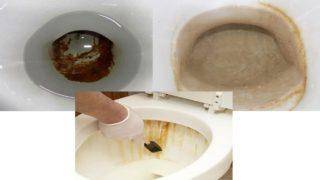 Lime and rusty deposits often form on the toilet
Lime and rusty deposits often form on the toilet
Lime or rusty deposits usually form on plumbing fixtures. There are deposits of water stone. Each of the pollution is caused by its own reasons.
Corrosion is formed due to the high content of dissolved iron and its compounds, as well as due to the destruction of cast iron pipes. The problem is relevant for areas of Soviet development, where water pipes of outdated models are still used.
The formation of limescale is associated with a large amount of calcium and magnesium dissolved in the water. In different regions and even districts of the same city, the percentage of mineral content may differ. The standard filtration system does not remove minerals and heavy salt compounds. The water supplied to the apartments through a centralized system undergoes only basic treatment, that is, large debris, harmful impurities and bacteria are removed.
Water stone is dried urea deposits.Biological waste penetrates into micro-crevices, forming build-ups and stains of pollution. Their layering occurs gradually. Frequent use of the toilet leads to the rapid formation of urinary stones.
Housewives tips: what to look for when cleaning?
If, in the case of a shower head or a tap aerator, the hostess can solve the problem herself, then difficulties arise when cleaning chrome surfaces.
These coatings must be cleaned with care. It is recommended to observe the following rules when washing them:
- Do not use metallized hard sponges to clean taps and plumbing fixtures. The resulting scratches cannot be removed.
- When choosing a chemical or folk cleaning method, do not use abrasives that damage the surface.
- If the composition of household chemicals contains hydrochloric, sulfuric or phosphoric acids - refuse to use this detergent. The consequences after it are as follows: the appearance of dark spots, as well as rust, which will be difficult to remove.
- Do not mix several detergents at once on your own - there is a high risk of damage to the chrome coating by such combinations.
- Ask your store consultant about specialty detergents for chrome. It is better to choose a substance, even if it is more expensive, but designed specifically for a specific situation.
Spoiled plumbing with the wrong choice of means will have to be replaced, which will result in large costs. At the end of the article, a recipe for a composition will be presented that will help restore chrome products with minor scratches.
It will not work to clean the aerator and shower without disassembling the device. Sometimes lime sticks strongly to the threads and prevents the parts from separating. In this case, vinegar is used, which is moistened with the desired place for at least 1 hour.
After disassembly, all parts of the aerator or watering can are treated in a special solution, the softened lime sediment is removed and the parts are washed in water. You can use an old toothbrush or toothpick to clean the holes in the shower spray.
Original faucets made of copper, bronze or brass differ in their appearance from chrome-plated faucets and therefore are in demand among buyers who prefer a refined interior. However, special care is needed to prevent the details from fading. Methods for removing limescale from precious metal taps are also different from those used for chrome plumbing fixtures.
The most common ways are:
- Brass is cleaned with a soft cloth or microfiber cloth soaked in a solution of soap, lemon juice and salt. Moreover, there should be no grains that could cause scratches. Using linseed oil, a brass faucet is polished to a shine.
- Cleaning the copper faucet from contamination is performed in the same way. It is better to remove limescale in disassembled form by boiling in a solution of water and vinegar.
- Bronze plumbing is characterized by the appearance of patina, so you need to take preventive measures with the help of special means or polish the faucet with wet chicory powder. Boil a bronze tap well in pea broth.
Parts such as chrome and nickel-plated surfaces - faucet handles, faucets, shower head - must not be cleaned with coarse abrasive particles, as they can leave micro-scratches. A proven method will come to the rescue - table vinegar and hot water. To do this, vinegar in boiling water is diluted in a large container, and the part to be cleaned is gently immersed in it.
Non-removable parts can be immersed in a bag with a poured mixture, in this case, instead of boiling water, use warm water and double the concentration of vinegar. For the usual proportion, use 100 ml per liter of water.
Liquid ammonia based descaler:
- Dilute alcohol with water in equal proportions.
- Cover lime accumulations with liquid or dampen a rag or paper towel with it and place the stain on the stain.
- Leave on for 30-60 minutes, depending on the thickness of the coating.
- Wipe with a sponge until the lime is completely peeled off.
- Rinse with cold water.
- Ventilate the room, as after the ammonia, a pungent smell remains.
Enamelled sanitary surfaces
To avoid damaging the enamel, do not use metal brushes for cleaning. The best option would be a soft foam sponge or cloth.
Of course, the surest way is not to run and regularly clean your enamelled tub and other enamelled plumbing fixtures. But over time, even with regular maintenance, rust stains, water stone deposits and other unpleasant consequences of long-term use, spoiling the appearance, may appear. How to completely clean enamelled plumbing and give it its original appearance?
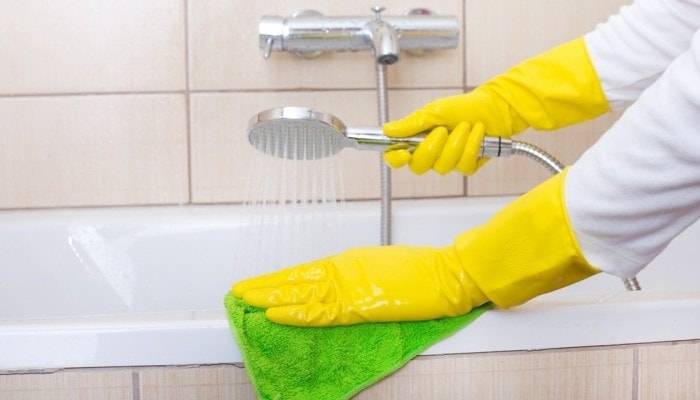
Acidic way
Lime deposits dissolve well with acids. The most popular household acids are acetic and citric. We will use them.
- Lemon acid. Take at the rate of 50 g for 2 cups of warm water. Dissolve so that no grains remain. Soak a soft sponge in the resulting solution and wipe the entire surface to be cleaned with it. Without rinsing, after 15 minutes, repeat the procedure, carefully walking through the contaminated areas. Dense limescale layers can be removed if you put a cloth or napkins soaked in the same acid solution on top of them and leave for 20-30 minutes. Then rinse off with water. If the deposits have not completely disappeared, the procedure can be carried out again.
- Vinegar. Instead of citric acid solution, you can use 9% vinegar (not essence!). The algorithm of actions is the same as in the previous case, just be careful - do not breathe in caustic fumes. After the vinegar treatment, the room should be ventilated.
Alkaline method
Mix baking soda and soda ash in equal proportions, add a little water to form a paste. Rinse the item to be cleaned with water to keep it moist. Apply the resulting gruel by rubbing it evenly over the entire surface with a soft sponge. Leave for 20 minutes, then wipe with a sponge dipped in clean water. Wash off.
Combined method
Both methods can be combined to achieve maximum cleansing effect. So, almost any limescale, rust streaks and other dirt from an enamel bath, sink and other enamelled products can be removed as follows:
- First, we act as in the alkaline method. We mix baking soda and soda ash in equal proportions, add water until a thick mushy mass is formed, which is then evenly spread over the enamel surface of the product. We leave for 20 minutes.
- Without removing the gruel that was applied a step earlier, gently rub everything with a soft sponge or rag dipped in 9% vinegar. We leave for 20 minutes.
- We moisten the sponge in clean water, wipe everything with it again, rinse it thoroughly and enjoy the cleanliness.
Do not forget to work exclusively with gloves, otherwise, together with dirt, you can also remove the skin from your hands.
5 methods to remove plaque
In addition to household chemicals, which must be carefully selected for each type of surface, folk remedies are very popular. They cleanse to whiteness and are safer for the body.
Vinegar
To wash a bathtub with an acrylic surface, you need to pour it up to the top with warm water and add a glass of vinegar. Leave it on for 3-4 hours. After draining the water, wipe it first with a damp cloth, then with a dry cloth.
The shower cabin is washed with heated 9% vinegar, which is mixed with water in equal amounts. You need to rub the stains with a cloth soaked in the solution and leave for 10 minutes. Then rinse with running water and wipe dry. You can still vinegar add to dissolved in water detergent and wipe off the dirt.To clean the tiles, you need to pour the solution into a spray bottle, spray on the surface and rinse with warm water after 20 minutes.
Old limescale deposits on the walls of the bathtub and sinks are cleaned in a more tricky way. Moisten a cloth in vinegar and put on dirt for half an hour.
To clean limescale and yellow deposits inside the toilet, you can also sprinkle it with vinegar and leave it overnight. And in the morning, rub it with a brush and rinse well with water. Can be substituted with acetic acid, but use small amounts. Metal taps are also cleaned in this way. It does an excellent job with rust.
Lemon acid
Citric acid will help remove limescale from the tiles. Dissolve 100 grams of powder in half a liter of hot water. The product is poured into a spray bottle, sprayed onto spots, and left for 5-10 minutes. Then wipe dry.
For the glass of the shower stall, you need to completely stir it in a glass of water. And be sure to make sure that there are no particles left as they can damage the surface. Fresh lemon will do the job well, too. The fruit is cut and rubbed with dirt. Citric acid is also suitable for an acrylic bath, replacing vinegar.
Soda
Lime spots are also washed with ordinary table soda with washing powder in a ratio of 1: 2.5. They are mixed in a glass of hot water. After dissolution, a sponge is moistened in the mixture and the dirt is rubbed. So leave minutes for 10-15 and then washed.

You can also add baking soda to any bath cleaner. It will help to deal with stains and remove invisible fresh plaque.
Toothpaste
Perfectly cleans away even old plaque in the shower stall with toothpaste or powder. They do not scratch the surface. You need to apply the product to the spots and leave for 10 minutes, then rub them with a soft brush. This method will give the cabin a whiteness and shine.
Ammonia
Alcohol is added to warm water in a ratio of 1:10, for example, 20 ml of ammonia per 200 ml of water. Moisten a cloth in it and put it on the spots. After an hour, wash off with cold water. But using this method, you need to ventilate the room well. The ammonia has a pungent smell. If it is not on hand, you can replace it with hydrogen peroxide. And if you mix them, you get a strong solution.
In this case, take a ratio of 1: 2 (100 grams of alcohol and 50 grams of peroxide). The jar for the mixture must first be washed and wiped dry. Pour half a liter of water into it, add the product and shake. Apply to a sponge and rub off dirt, then rinse well.
How to remove limescale with vinegar?
Before you start cleaning the tap with vinegar, you should prepare a container for the procedure. It is better if the tap is completely in the tank. Next, a solution of water and vinegar is placed in a bowl in a ratio of 20 to 80%.
The watering can and all its components are lowered there. Leave them overnight (up to 6 hours). If plaque particles remain after treatment, you can get rid of them with a toothbrush or other non-metallic objects.
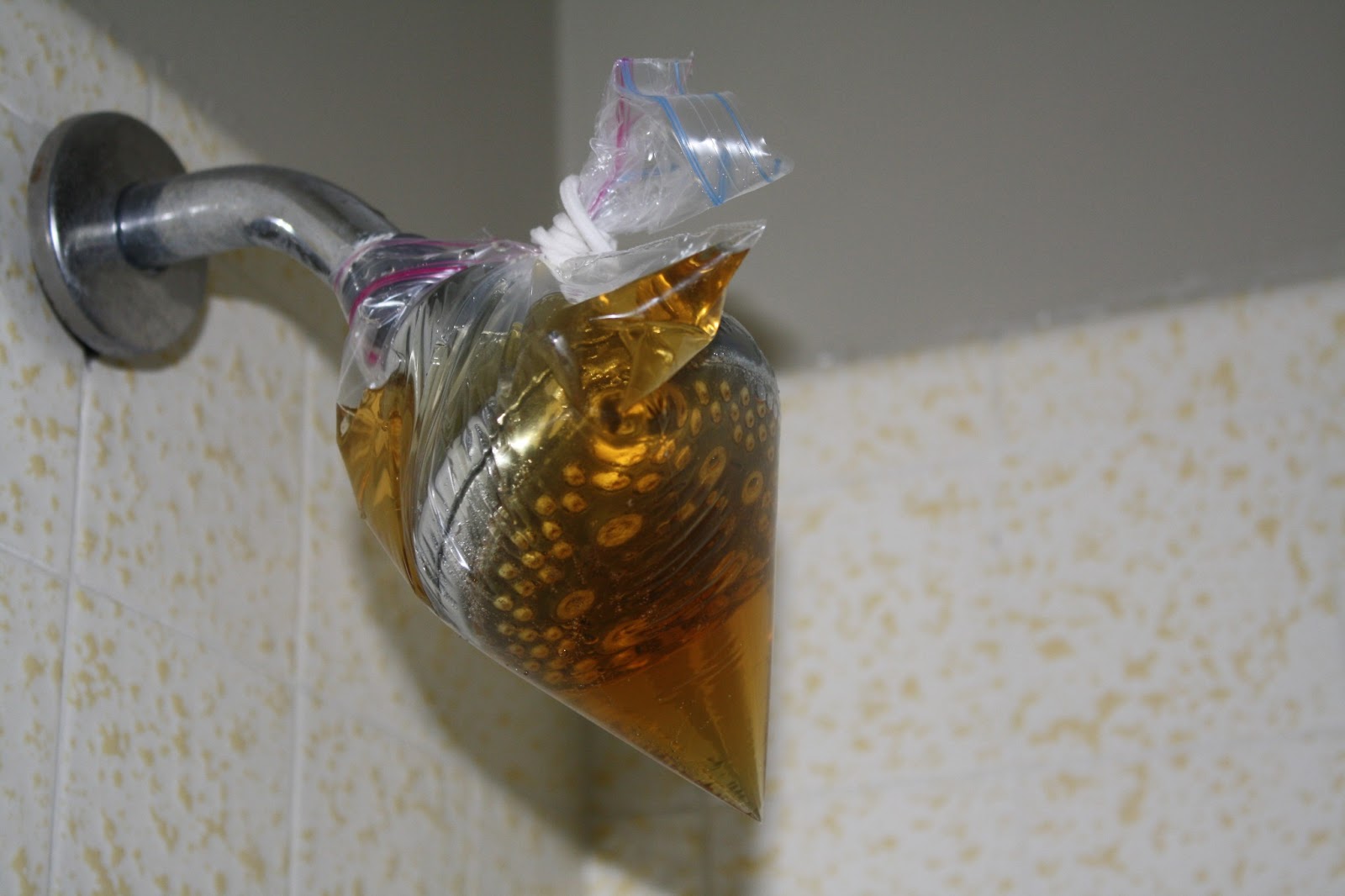
After completing the procedure, the watering can is connected to the pipes, and warm water is turned on at maximum pressure. In this mode, it should work for at least a minute.
Cleaning the faucet from plaque, rust, and other contaminants
Plumbing faucets are a typical target for limescale deposits. You turn off the water with wet hands, the drops dry out, the shine disappears. If cleansing is not done immediately, cleaning will be more difficult; within a few weeks or months, the tap clogs up so much that it becomes very difficult to return it to its original state.
Non-aggressive natural remedies
You can remove loose limescale with lemon juice.
Stir the juice in water, add baking soda (but be careful, make sure that it is not aggressive to the surface). Wipe with a cloth soaked in the mixture, rinse, polish
Funds from manufacturers
Many manufacturers recommend using special products for cleaning their products (for example, you can use a cleaning agent of the same name to clean the Grohe ball mixer). Such substances help to clean the water stone in a matter of minutes without damaging the chrome-plated surface. But unlike folk remedies, their purchase will somewhat affect the contents of the wallet. This is the best solution for heavy plaque.
Buy a matte faucet
Glossy taps look elegant, but the eye-pleasing appearance deteriorates when covered with dried water droplets. Matte ball, single-lever mixers will look better when used, as thin deposits are less visible on them. In addition, almost everything is in vogue today; a good combination of the matte surface with the rest of the bathroom will give it a great look.
On the other hand, one must understand that the problem does not disappear, but only disappears. Every drop won't be visible on the frosted faucet, but don't underestimate the care. This will prevent permanent damage.
Cleaning old taps
Previously, faucets were often made of brass, not chrome plated; bronze items were often found. They are still present in homes today.
You can clean bronze, brass taps, get rid of rust using acid:
- Rinse the surface with dish gel.
- Soak the cotton wool with phosphoric acid (you can buy it at hardware or garden supply stores).
- Cover the entire surface of the tap (mixer, spout), cover with polyethylene, if necessary, secure with an elastic band. Leave on for 2.5 hours.
- After the specified time has elapsed, remove the polyethylene, wash off the acid (either with soapy water or face milk), leave for another 3-5 minutes.
- Wash with detergent, polish.
How not to clean the faucet
Chemicals are not suitable for every surface. Shiny chrome faucets are very sensitive, choosing the wrong chemicals can cause them irreparable harm!
Commonly used vinegar can also be dangerous. It cleans perfectly, but is capable of negatively affecting the surface to be cleaned.
Use it with care
When cleaning, do not use harsh sponges, powdered chemicals, brushes, etc.


